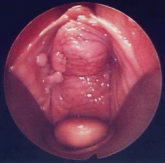The prolapse is due to the progressive weakening of the supporting tissues of the uterus and the vagina in situations such as pregnancy and childbirth, especially difficult and prolonged labour.
The supporting tissues become even weaker when you enter the menopause and as you grow older. If you are involve in strenuous physical work, or suffer from chronic cough and constipation, you have an increased tendency to develop pelvic organ prolapse.
Other causes include congenital weakness of the pelvic floor muscles, ligaments and fascia and collagen deficiency.


















